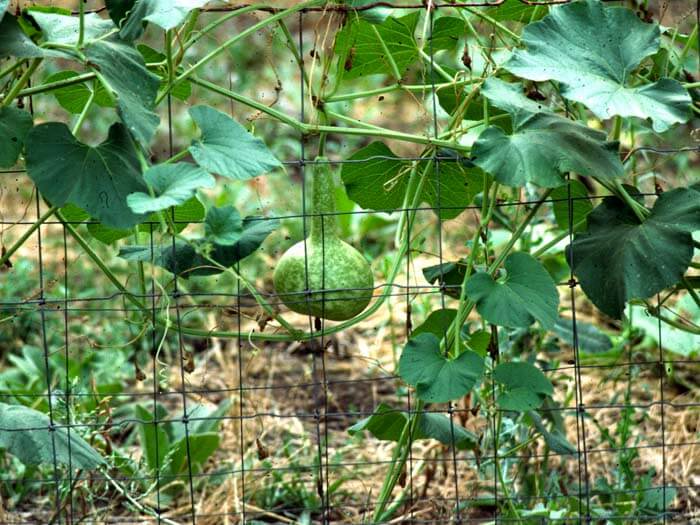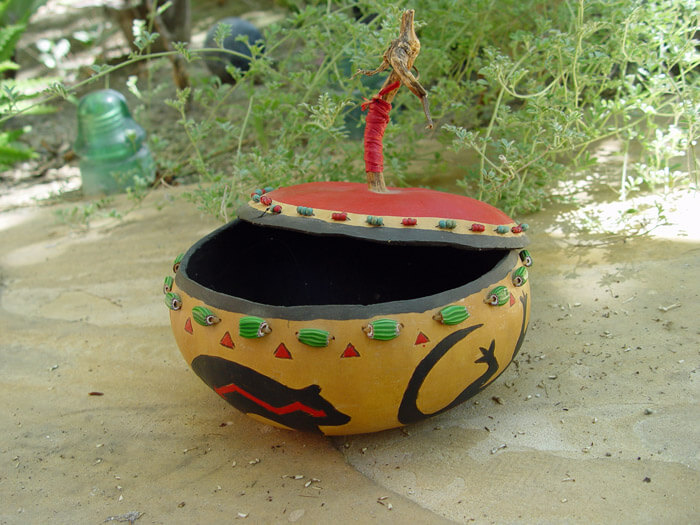The calabash or bottle gourd (Lagenaria siceraria) has been valued worldwide since ancient times and believed to be one of the oldest plant introductions into the Americas. Early botanical research has long attributed the origins of American bottle gourds to Africa, believing specimens floated across the Atlantic to reach the New World, though some studies tell a different story. Regardless of their path of arrival, these versatile gourds were an asset to early American peoples.
Gourd Origins

Native to Africa and Asia, bottle gourds were first introduced to the Americas 10,000 years before cultivation. Most believe that they passively arrived at the New World via ocean currents from Africa, but a few researchers believe that human beings intentionally brought them as they moved eastward into North America. The gourd’s strong, lightweight shells would have been ideal for portable containers carried by nomadic peoples to the New World. Gourd shapes would later become the models for the first Native American ceramic vessels, which were heavier and preferred by more settled cultures.
Choosing seed from plants that produced larger or different-shaped gourds was an early example of selective breeding by human beings. Soon the fruits were far larger than their wild-type progenitors. Gourd variations made shapes suitable for canteens, dippers for drinking, ladles, and even storage containers. The sheer diversity of gourds grown today descends from human intervention.
Why Plant Gourds?

In America, the love of gourd arts and crafts remains the chief reason this plant remains in cultivation. Learning to create with gourds is an age-old skill that’s fun to learn and even more rewarding if you grow your own gourds. Small-budget gardeners will find gourd art-and-craft costs next to nothing, and the results are highly coveted handmade containers and gifts.
Bottle gourds are a cousin of winter squash and just as easy to grow. Commercial growers let them ramble across fields of rich agricultural soils, demonstrating how much water and nutrition they need to mature, though they will tolerate high heat and moderate drought as the summer heats up.
Growing Gourds

Sow seeds in native soil enriched with Black Gold Garden Compost Blend and Black Gold Earthworm Castings to ensure plenty of microbes and fertility for big, strong gourds. Plant them outdoors after the threat of frost has passed, and give them plenty of space to grow.
Even if you don’t have space to cultivate them in a field, gourd vines are happy grown on fences and arbors, too. They thrive on chain link or woven field fence where their tendrils can hold on tightly. Gourds that hang tend to be far more symmetrical with rounded bottoms. It’s traditional to grow long-handled dipper gourds from overhead trellises for straight handles. Gourds are grown on the ground and set upright early make better stand-up pots and vases because their bottoms develop flat.
Gourd vines bear both male and female flowers, which are white and held on thin stems above the foliage. Unlike bee-pollinated winter squash, gourds are pollinated at night by moths. Male flowers are produced first and female flowers follow. Aficionados often pinch off some male flowers to force more female blooms to increase yield. Vines are allowed to die back at season’s end; then gourds are left in the field to cure naturally in the sun before storing for winter.
Curing Gourds

When gourds mature, they are still quite heavy because the tissues contain a great deal of moisture. A gourd requires up to a year to dry out fully and become ready to make into containers. To speed the process, drill a few small holes in the top and bottom of a fresh gourd to help moisture escape. Cure gourds overwinter in a dry place, such as a garage or barn loft.
Some folks dip their gourds in a mild bleach solution prior to winter curing to discourage discoloring mildew and fungi. If molds do form, don’t try to remove them as this interferes with the gourd’s outer surface integrity and patina. Mold can be easily removed much later when the gourd is completely dry.
Gourds are commercially grown all over America, proving their universal appeal and utility. Autumn is the best time to see them in their natural state at pumpkin patches in the fall.
This year don’t stop with pumpkins, select gourds you’d like to grow, too. Come spring they’ll be dry, and their internal seeds will be ready to harvest. Plant first-year seeds to grow gourds for many years to come without spending another penny.


